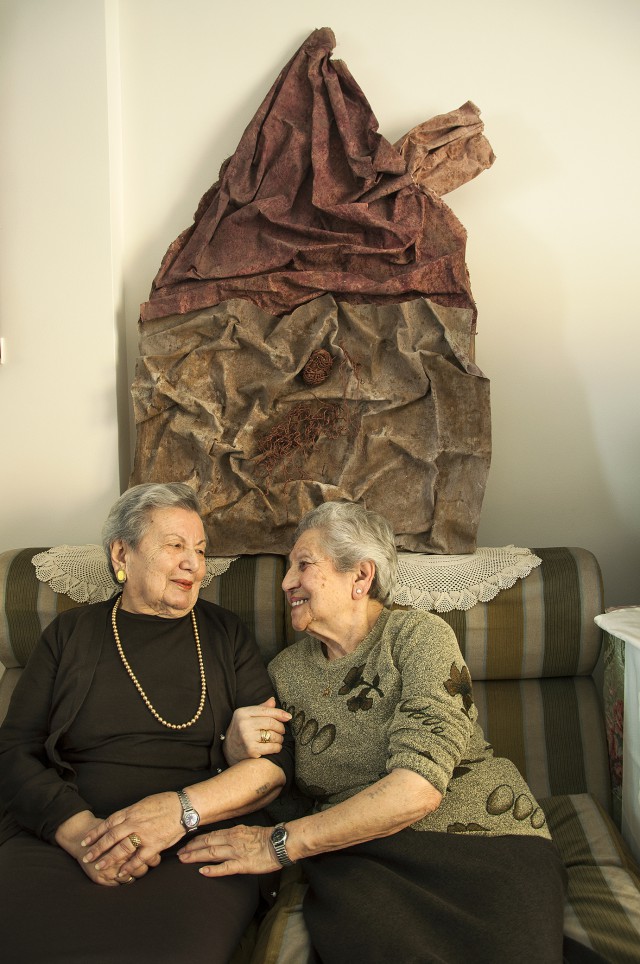|
back to Texts - Press
A study on trauma, memory, loss
by Nikos Vatopoulos
Translation: Celia May
 Photo caption: Photo caption:
Eriketti Velleli with her current Christian name Fotini Rapsomaniki confesses that her mother in law in Corfu attempted to remove the number from her arm using various acidic potions.
As the photographs add up, one by one, like urban aquariums of memory and a motionless daily routine, there doesn’t appear to be any intention to record. Moreover, these portraits emerge like stems of a large bouquet, tied in a ribbon that passes from one generation to the next.
For Artemis Alcalay the need to meet the Greek Jewish survivors of the Holocaust, extending her eye over what has propelled her over the last few years as an artistic creator; namely a study on the ‘home’, the house, the habitat, the memory, the loss, the trauma and the healing.
These photographic portraits can be seen not only as part of a project but as ‘sacred’ approaches of solitary journeys.
“Each one of us is very important in himself” says Artemis Alcalay, who for the last months has photographed 19 Nazi Concentration Camp survivors in their own homes, in their own rooms, in Athens or in Thessaloniki or in Yannena and soon in Rhodes, people who gradually opened up in front of the camera, to experience an openness as necessary for their preservation as their own loneliness”. They desire the contact, not so much to narrate their own story but because they crave the interaction, they want love and respect.”
Personal submersion
For Artemis Alcalay every meeting was a personal submersion as well as an opening, each time in a different world. She found herself with these heroic everyday figures, who carry the number of the Camp, a grey-green stain on the arm, “a sign that directs the trauma, that activates the memory. The number is not there accidentally”. At present Artemis Alcalay is searching for more Greek Jewish survivors who are dispersed in various places.
“I am trying to coordinate with a survivor from Rhodes, who lives in New York but will be here in the summer. She told me that when she went to America she had the number removed. My father’s first cousin did the same when she went to France. One of the women, who now has a Christian name, and is called Fotini Rapsomaniki, told me that her mother-in-law in Corfu tried to remove her number using a variety of acidic potions. Most of them live in their own homes or with a member of their family, others reside peacefully in Nursing homes. “Some have never spoken about the past. They don’t want to exist in this ‘space’.
As Artemis Alcalay has incorporated this project into the larger body of her work ‘Home a wandering’, like a big map of emotions and behaviors, she brought with her to each visit a ‘little home’, her own creation, which became part of this spiritual passage.”As if they forgot the past, the present and the future for a short while and became children again” she says.”We cannot erase the little house with the chimney from our memory. The archetypal house is understood by all cultures. It was my passport to opening doors. This little house opened hearts”. The soothing effect of the shape, the presence and symbolism of the little ‘house’ which like a toy changed the codes of stereotyped communication and led to a series of portraits like allegories around the meaning of geography, family and spiritual ‘home’. The subject is in dialogue with the historical content.
With ages between 89 and 104, the subjects of these photographic portraits are released in a dynamic silence. Their existence springs as physical beings on journeys into the deep grooves of their tragic yet recent historical destiny, having this cryptic, ambiguous, inescapably defining relationship of repulsion and legality. It is a valve which opens and closes.
Blending and meditation
For Artemis Alcalay the issue is the exposure of the spiritual plane and the unique meaning of each person in a field of interaction that may extend, communicate and bring about a blending and reflection even beyond the Jewish identity. To be an active figure that talks about the human condition and the need for a way to happiness or oblivion. Artemis Alcalay reminds us that in the first decades after the war most survivors had chosen silence.”After the 1980’s and more so the 1990’s the issue of the Holocaust begins to enter the sphere of public discourse” she says. In Greece it is only in the last 20-25 years that we have cultivated speaking publicly about Greek Judaism, testimonies, conferences and original research work.
Today, these fragile figures are a connection not only with the past but with something beyond time and History. They are a huge family portrait in which we are all mirrored.
Event in Tel Aviv
Artemis Alcalay’s photographic project will be presented in the Beth Hatefutsoth Museum of Diaspora in Tel Aviv this fall. The event will take place relating to the Greek Jewish Communities, an initiative of the Greek Ambassador to Israel Mr.Spyros Lambrides organized by the Jewish Museum of Greece and the Beth Hatefutsoth. Except for Artemis Alcalay’s photographic exhibition there will also be the projection of the award winning documentary “Kisses to the children” by Vassilis Loules as well as the participation of the Historian Odette Varon-Vassar.
1.The sisters Fortouni Gani and Chrysoula Eliasa.These delicate figures are a reconnection not only with the past but with an entity beyond time and history.

2.Heinz Kounio photographed in his home in Thessaloniki.
3. With ages between 89 and 104, the subjects of these portraits, like Dino Matsas are suspended in/left in/submit to/surrender to/ a dynamic silence.
top
|



